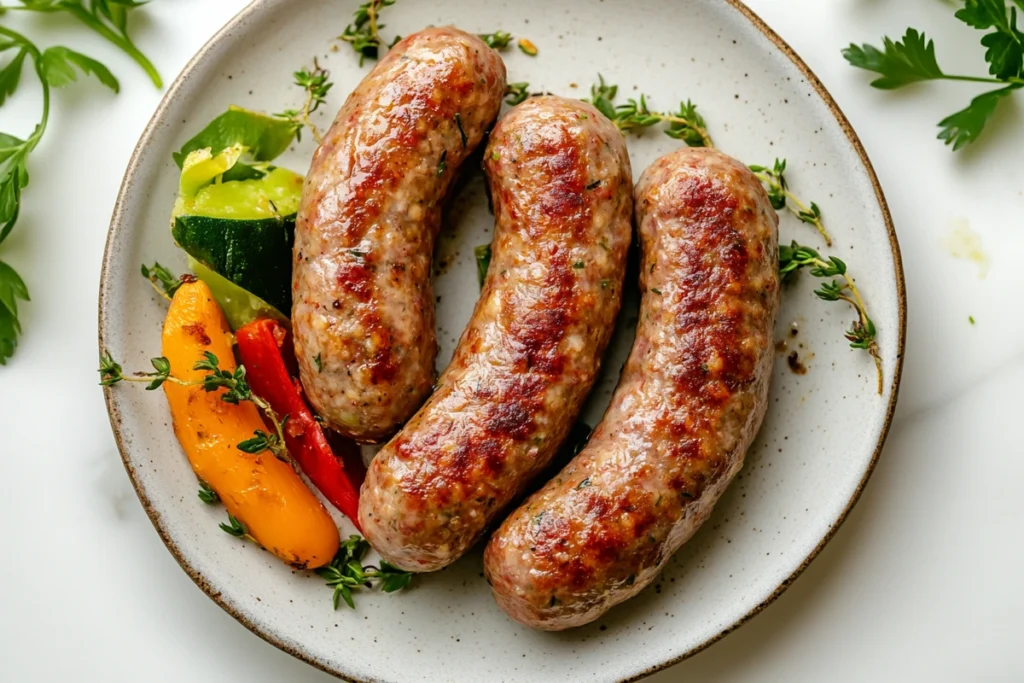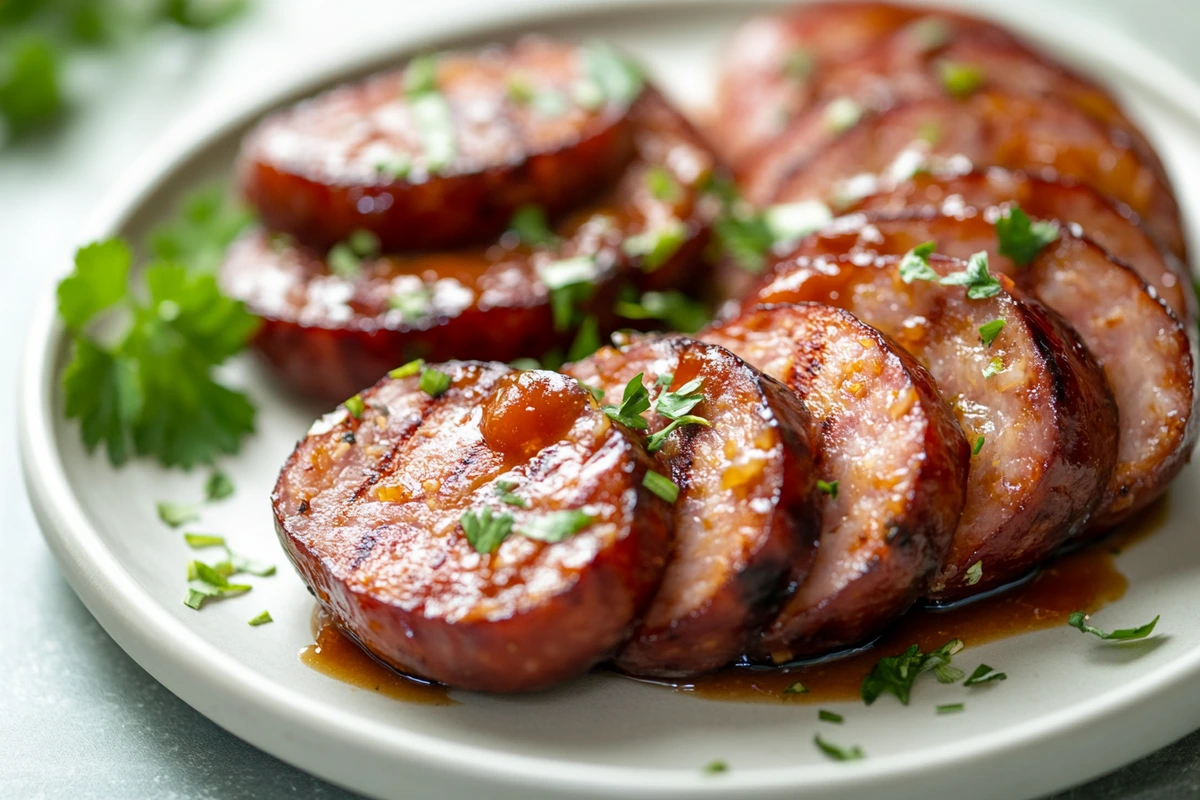Introduction
Are you searching for a versatile vegan sausage with bold flavor? Field roast sausage might be your next favorite. In this article, we explore essential details, cooking tips, and serving ideas that maximize this plant-based option.
I. Overview of Field Roast Sausage
A field roast sausage is a plant-based twist on traditional sausages, blending grains, vegetables, and spices to achieve a meaty bite. Because it’s made with quality ingredients, the sausage delivers savory satisfaction without relying on animal products. Moreover, it fits well into many diets, including vegetarian and vegan lifestyles. Generally, field roast sausage stands out for its hearty texture, robust seasonings, and convenience.
A. Defining Field Roast Sausage
At its core, this sausage is a vegan alternative made from wheat protein or other grains, combined with herbs, seeds, spices, and often apples or other fruit notes. Unlike typical soy-based products, field roast focuses on flavor and mouthfeel through real food elements, not isolated proteins. Indeed, the result is a sausage-like link that browns, slices, and crumbles in many recipes.
B. Why Choose Field Roast Sausage
Many people select field roast sausage because they want a protein source that’s free from meat but still satisfies cravings for savory taste. Another reason is convenience. You can toss these sausages onto a grill, skillet, or sheet pan, and they cook in mere minutes. Meanwhile, the brand’s emphasis on natural ingredients suits those aiming to reduce processed foods. Furthermore, their options often include creative seasonings, appealing to adventurous home cooks.
C. Short History of Field Roast
The Field Roast brand launched in the late 1990s, combining European charcuterie craftsmanship with vegetarian ideas. Over time, the company expanded to multiple products, including roasts, deli slices, and sausages. Field roast sausage has since become a go-to for many seeking deeper flavors than generic vegan links. Particularly in the U.S., it’s one of the top picks for vegan barbecues, breakfast plates, and pasta dishes.
II. Benefits of Field Roast Sausage
There are numerous reasons to incorporate field roast sausage into your meals, and not just for the flavor. Below are key advantages.
- Plant-Based Protein: Supports muscle maintenance while avoiding cholesterol.
- Minimal Prep: Cooks quickly, suitable for busy lifestyles.
- High Flavor Profile: Spiced to mimic or surpass traditional sausages.
- Versatile: Works in pasta, sandwiches, pizzas, and more.
Meanwhile, for a balanced plate, pair the sausage with a veggie side or a bowl of Zucchini Pasta. This combination merges fresh produce with hearty protein, making a complete meal.
III. Choosing the Right Field Roast Sausage
To ensure a satisfying culinary experience, it’s crucial to pick a field roast sausage variety that aligns with your tastes. The brand offers multiple flavors, such as Italian, Chipotle, and Apple Sage, each suiting different dishes.
A. Checking Labels
When browsing the roast sausage, read the label for flavor descriptions and recommended uses. Some, like Italian, blend well with tomato sauces or pizza, whereas Chipotle might star in Tex-Mex meals. Another way is to look for the Apple Sage variant, which pairs seamlessly with breakfast or holiday recipes.
B. Considering Dietary Preferences
Because field roast sausage primarily uses wheat gluten, it’s not gluten-free. People with celiac disease or gluten sensitivity should avoid it. Still, if you follow a vegan or vegetarian diet, or merely wish to cut down on meat, this product suits you. Another plus is that many variants are non-GMO and free from artificial flavors.
C. Assessing Cooking Methods
Think about how you plan to prepare field roast sausage. For example, if you plan to grill, the sausage’s casing helps it hold shape. If you need crumbles for pizza or tacos, pick a variety you can easily slice or break up. Generally, each flavor stands up to sautéing, roasting, or grilling.
IV. Cooking Methods for Field Roast Sausage

Preparing field roast sausage is straightforward, mainly because it’s precooked or par-cooked, requiring just a little browning. Below are popular cooking approaches, along with tips to preserve optimal taste and texture.
A. Stove-Top Sauté
- Heat a Skillet: Use medium to medium-high heat with a small amount of oil.
- Slice or Whole: If you want medallions, cut the field roast sausage into rounds. Otherwise, keep it intact.
- Cook Briefly: Sausage only needs a few minutes per side until browned. Overcooking can turn it rubbery.
- Add Onions or Peppers: If desired, toss vegetables into the same skillet for a quick stir-fry.
B. Baking in the Oven
- Preheat Oven: 350°F (175°C) is typical.
- Line a Sheet: Use foil or parchment for simpler cleanup.
- Arrange Sausage: Place links, spaced out, on the tray.
- Bake: Cook for 15–20 minutes, flipping halfway to ensure even browning.
- Monitor: Watch for color changes; the roast sausage shouldn’t dry out excessively.
C. Grilling Techniques
For outdoor barbecues or indoor grill pans:
- Preheat Grill: Medium-high temperature suffices.
- Light Oil: Lightly brush the grate or sausage with oil.
- Grill: Cook the roast sausage for about 5 minutes per side, rotating for cross-hatch marks.
- Add Sauces: If using marinade or barbecue sauce, apply near the end to prevent scorching.
V. Delicious Ways to Use Field Roast Sausage
Field roast sausage integrates well into countless dishes, from breakfast hash to comforting stews. Thanks to its savory nature and firm texture, it stands up to various cooking styles.
A. Breakfast or Brunch Dishes
- Scramble: Slice the roast sausage, then combine with scrambled tofu or eggs.
- Skillet Hash: Cook diced potatoes, peppers, onions, and sausage in one pan.
- Breakfast Burritos: Roll sausage, beans, and salsa into a tortilla.
- Side with Toast: Pan-fry sausage links quickly, accompanied by Avocado Toast with Feta for a protein-packed start.
B. Lunch and Dinner Classics
- Pasta Toppings: Crumble sausage over spaghetti or use in lasagna.
- Pizza Topping: Slice into rounds and place on pizza with tomato sauce, peppers, and cheese (vegan or dairy).
- Grain Bowl: Pair sausage with quinoa or rice, plus roasted vegetables.
- Soup or Stew: Slice or crumble sausage into soups like Vegetarian Tortilla Soup to add savory depth.
C. Sandwiches, Wraps, and More
- Submarine Sandwich: Load with onions, peppers, marinara, and melted cheese.
- Wraps or Tacos: Combine with veggies, lettuce, and sauces in a tortilla or flatbread.
- Calzones: Hide slices inside dough with sauce and mushrooms for a hearty lunch.
- Kebabs: Alternate sausage chunks with zucchini or tomatoes, grill, and enjoy.
VI. Storing and Reheating Field Roast Sausage
Because field roast sausage comes partially cooked, it can last relatively long in the fridge. Nonetheless, proper storage keeps it tasting optimal.
A. Refrigerator Guidelines
Unopened packages can stay in the fridge until the expiration date, typically a few weeks. Once you open it, seal in a zip-top bag or wrap in plastic. Then consume within 3–5 days. If you see any unusual odor or color, discard the product.
B. Freezer Tips
- Wrap Tightly: Either keep the original sealed pack or move leftover links into freezer-safe bags.
- Label with Date: Knowing how long it has been in the freezer helps maintain freshness.
- Thaw Safely: Transfer to the fridge overnight. Alternatively, thaw under cold running water if necessary. Avoid leaving it on the counter.
C. Best Reheating Practices
When you reheat a cooked field roast sausage, use gentle heat. Overcooking leads to dryness or a rubbery texture. Microwave on low power or warm in a skillet with a sprinkle of water or oil to prevent scorching.
VII. Nutritional Highlights of Field Roast Sausage
For many, a major motivation for eating the roast sausage is the nutritional aspect. By substituting meat, you lower cholesterol intake while still getting protein.
A. Protein and Calories
The brand aims to provide a decent protein content per link—often 20 grams or more, depending on the variety. Calories can vary, but typically you’ll see around 200–250 calories per sausage, subject to flavor. Because the recipe uses real foods like wheat protein, apples, or onions, the macros differ from typical processed vegan items.
B. Fat and Sodium
Some flavors contain moderate fat levels—mainly from healthy oils or seeds. Meanwhile, sodium may be moderately high, as with any sausage product, so read nutrition labels carefully. If you watch your salt intake, choose accompanying sides that are lower in sodium, or skip adding extra salt.
C. Vitamins and Minerals
Although field roast sausage can’t replicate every nutrient found in meat, it often includes iron, fiber, and certain B vitamins from grains and added ingredients. Check the packaging for specifics. Another tip is to pair your sausages with fresh vegetables, like tomatoes or peppers, boosting the overall meal’s nutrient density.
VIII. Cooking Tips and Tricks
Creating a satisfying meal with the roast sausage doesn’t require advanced expertise, but a few pointers help maximize flavor.
A. Marinating for Extra Flavor
Though field roast sausage is already seasoned, marinating can intensify taste. Use a marinade of olive oil, herbs, or a dash of vinegar. Let the sausage soak for 15–20 minutes in the fridge. Another method is to brush marinade on during grilling, building layers of flavor.
B. Slicing Before Cooking
If you plan to add sausage to pasta or stir-fries, pre-slice or dice before cooking. That ensures quick browning on each piece, plus simpler distribution among other components. Then you can toss it all together with minimal fuss.
C. Crumbling for Tacos or Pizza
Field roast sausage breaks apart easily after removing the casing, if any. Just crumble into a hot pan. This approach works well for tacos, pizza toppings, or a side dish with scrambled tofu. Overcooking in crumble form can lead to dryness, though, so keep an eye on the stove.
D. Using the Oven for Mess-Free Meals
Sheet pan dinners with the roast sausage can save time. Chop sausage, onions, peppers, and potatoes. Spread on a tray, drizzle with oil, then bake. This method yields a hearty, one-dish meal with minimal cleanup. Add a side like Zucchini Pasta for extra fiber.
IX. Serving Suggestions to Complement Field Roast Sausage

While field roast sausage can stand alone, pairing it with a variety of sides or condiments upgrades your meal to a memorable feast. Plant-based fans often incorporate a wide selection of grains, salads, or sauces.
A. Grains and Pasta
- Polenta: Sliced sausage on creamy polenta is mouthwatering.
- Quinoa or Brown Rice: Balance the savory sausage with earthy grains.
- Pasta Salads: Add chunks of field roast sausage to a cold pasta salad, mixing in vegetables and a tangy dressing.
B. Soups and Stews
Slice or crumble the sausage into bean or lentil soups for a smoky, meaty boost. Additionally, a classic tomato-based stew can transform into a robust dinner with the simple addition of field roast sausage.
C. Sandwiches and Wraps
Place slices on toasted bread, topping with roasted peppers, onions, or a drizzle of mustard. Another approach is to wrap sausage slices, lettuce, cucumbers, and sauce in a tortilla. The resulting lunch is quick, portable, and nourishing.
D. Pairing with Salads
If you want a lighter meal, add the roast sausage to a fresh green salad. A simple vinaigrette complements the sausage’s dense flavor. Another option is a grain-based salad—like farro or barley—where the sausage stands out as a star ingredient.
X. FAQs about Field Roast Sausage
What is Field Roast sausage made of?
A field roast sausage consists of a blend of wheat gluten, vegetables, seasonings, and natural flavors. It typically uses whole-food ingredients, like apples or onions, plus herbs and spices.
Do you remove the casing from the Field Roast sausage?
Often, the casing is edible. Some prefer to remove it if they want to crumble the sausage. Otherwise, keep it on for grilling or pan-searing. This is a matter of personal choice.
Are field roast sausages already cooked?
Yes. Most types of field roast sausage come fully or partially cooked. You only need to warm or brown them. This makes meal prep quick and easy.
Are field roast sausages ultra processed?
They do undergo processing to combine wheat gluten, spices, and other plant-based components. However, they typically contain fewer artificial additives compared to many conventional plant-based meats, focusing on real-food ingredients instead.
Conclusion
A field roast sausage transforms plant-based eating from routine to exciting. With robust flavors, flexible cooking methods, and compatibility in diverse cuisines, it’s no wonder this sausage has won hearts among vegans and omnivores alike. Furthermore, you can grill, sauté, or bake it in minutes, making mealtime stress-free. Whether you enjoy it in breakfast scrambles, slice it onto pizza, or nestle it into a grain bowl, you’ll be rewarded with savory satisfaction. Try it soon and experience a new world of plant-based protein that defies expectations.

